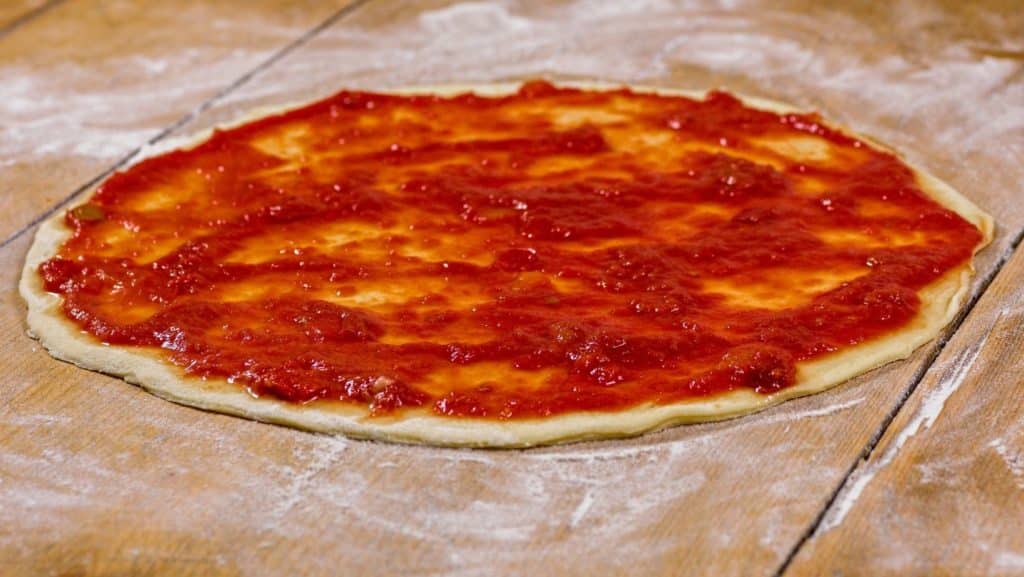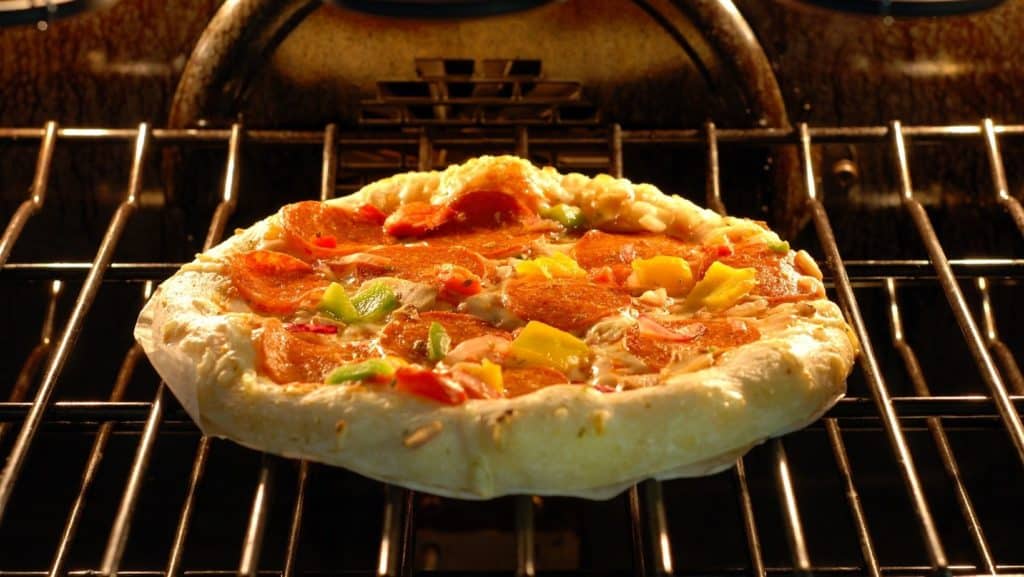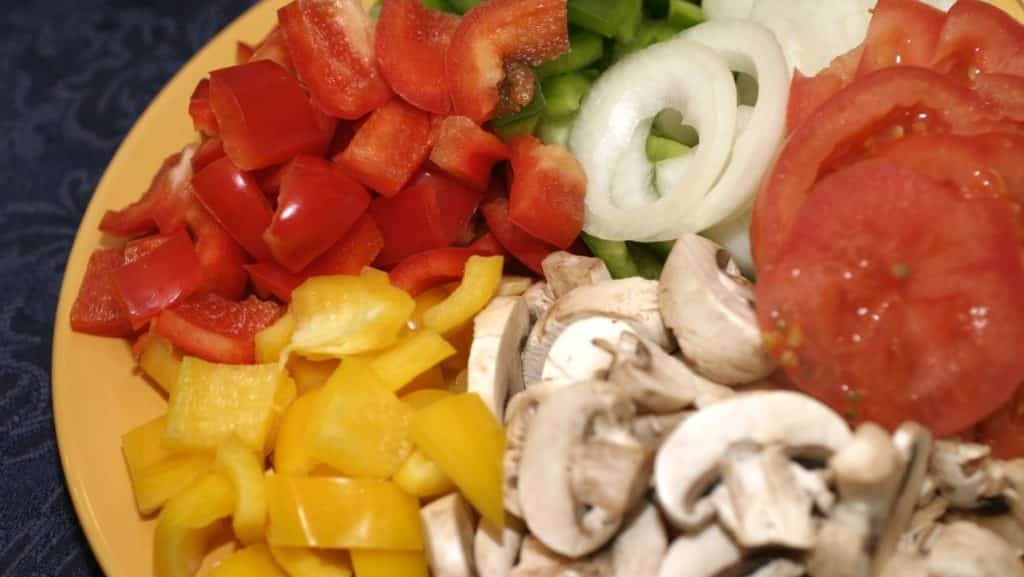
We’ve all been there – you decide to make a pizza, you spend your time making the perfect dough, add your toppings and pop it in the oven. Then disaster, when you get it out the base is soggy. A soggy pizza is common, so your not alone.
In this post, we’re going to take a look at how to fix a soggy pizza base, the most common mistakes, and how to fix them. So whether you’re an amateur or a a pro at homemade pizza, read on for some tips that will help you create the perfect crispy pizza every time.
What Causes A Soggy Pizza Base?
You’ll get a soggy pizza because of the amount of moisture either in the pizza dough or in your toppings.
First with the toppings you need to make sure high moisture ones such as onions and mushrooms are cooked before going on the pizza.
To get a nice crispy pizza crust, the moisture in the dough needs to evaporate. There are two things that help with this, baking time and the temperature that your pizza is cooked at.
So either baking your pizza longer or at a higher temperature will prevent a soggy pizza.
However, the most common causes of a soggy pizza are;
- Your haven’t cooked your pizza enough and parts are raw
- The oven is not hot enough (A pizza oven or Pizza stone can help)
- High moisture toppings that have not been pre-cooked
- Too many toppings used on your pizza
- Pizza didn’t sit for a little after baking
- If reheating, it was not reheated correctly
- Pizza was left covered over with something
How To Fix a Soggy Pizza Base
Right, so you’ve just got it and you find your have a soggy pizza. What do you do?
NO, don’t throw it away… You can fix it!
It’s soggy because there is too much moisture, so you want to put it back into the oven and bake it for a little longer.
A couple more minutes should be enough, depending on how soggy the pizza is.
Now I mentioned that a pizza stone can help, just make sure its still hot to prevent it from breaking. The stone will give it that extra heat that you typically get from a traditional wood fired pizza oven.
If you do pop it back into your oven for a couple of minutes, keep an eye on it. It doesn’t take long going from cooked too burnt. But keep an eye on it to check when it’s done, and to make sure it doesn’t burn.
What if the top is cooked before the base?
This has happened to me a lot, even more so if the pizza bas is to thick. What you need to do is cover over the top of the pizza and then place it back in the oven.
This should help protect the top from burning but continue cooking the soggy pizza base, to get the moisture out.
Aluminum foil works the best to cover the pizza over.
When Can A Pizza Get A Soggy Base?

You can end up with a soggy pizza at any point during the process.
Depending on what point in making your pizza you are, could be the reason why your pizza becomes soggy and not crisp.
You need to look at potential mistakes and how to fix them whilst making the pizza, after you’ve baked it and even when your reheating it.
Below i’m going to go through each of these different stages, the issues that causes the sogginess and how to fix/prevent it.
The Reasons Why You Get A Soggy Pizza and How To Fix Them
Before your pizza is even finished cooking, there are things that could cause it to become soggy. If you can see which of these you’re doing, you can fix it and make perfect crispy pizza.
Pizza is not fully cooked
A common mistake (in fact one of the most common) is not actually baking the pizza enough. If its underbaked then your going to end up with a soggy pizza. Not only that but it’s not going to taste as good.
Luckily this is easy to fix.
You just need to make sure you cook it at a hotter temperature to help cook off the moisture or bake it for longer.
The pizza base has a lot of moisture in it. Baking will cause the water in the dough to evaporate, which will give it that crispy finish.
One of the reasons why traditionally pizza is cooked in a pizza oven is because of how hot it gets.
It gets so hot that it bakes it faster so it gets you that lovely crust without causing it to dry out.
The result is one of the best types of pizza crust you can get. Crispy on the outside and chewy on the inside.
Oven Doesn’t Get Hot Enough

The problem that many people face is that your home oven is just not hot enough to bake perfect pizza. For example Neapolitan pizza needs to be baked at over 400 degrees.
This is an issue in a home oven as the top of the pizza bakes but by the time thats done, the bottom is still undercooked. Resulting in a Soggy Pizza.
Now Id recommend getting an outdoor pizza oven to help you create the very best pizza.
If however you don’t want to do this then dont worry, there is a way to get perfectly cooked pizza in your home oven.
To do this you need to use a pizza stone
You put the pizza stone in the oven when you first start to heat it up. This is so the stone heats up with the oven.
Once its been in for 45-60 minutes, you simply place the pizza on the top of the stone.
The stone gets incredibly hot, so whilst the oven is baking the top of the pizza the stone crisps up the bottom.
This will really take your pizza making to the next level and produce some incredible pizzas.
Watery Pizza Sauce
Tomatoes are well-known for having a high water content, so its understandable that this can add extra moisture to your pizza dough. (Check out this pizza sauce recipe for my go to sauce)
There are two ways of preparing pizza sauce, either cooked or uncooked.
Its much easier to reduce the water content in cooked sauces, as you simply cook it for longer so that it thickens up and the water evaporates. Once done you then spoon it onto your dough. This will prevent you from having a soggy pizza base.
If you decide to go for uncooked sauce then you could run into a few problems. What you need to do is try and drain off as much of the water as possible.
This is very hard if your using chopped or crushed tomatoes.
The best type of canned tomatoes to use would be whole or plum tomatoes. These will remain even when you drain the liquid. You can then crush these yourself and you’ll find your raw sauce to be much thicker.
Again this will prevent the base of your pizza from getting soggy.
NOTE: Using too much sauce will also make your pizza soggy, so you only want to spoon on a thin layer.
Cheese Can Make Your Pizza Soggy

When I first started making pizzas, they kept on getting a soggy middle and I couldn’t figure out why.
It wasn’t until I made a pizza without cheese that I’d realised it was the cheese making the pizza base soggy. I couldnt believe it…
So I started testing different combinations and found out the reason why.
If you use a cheese that has a high fat content, you’ll find that it does contain a lot of oil. As the yummy cheese melts, this oil goes into the pizza which results in it becoming soggy. (especially in the middle)
Now there is another cheese that is on most pizzas and does the same thing…can you guess what it is?
Thats right Mozzarella!
You see Mozzarella is a very wet cheese, so before you add it to your pizza you need to make sure you drain it will. Or else all that liquid is going to end up on your pizza.
Not Precooking Certain Toppings
This a very common mistake, so don’t worry if you’ve fallen to this one.
There are certain toppings that should be pre-cooked before you use them. This is toppings like onion, mushrooms and even bell peppers.
These should be pre-cooked because they have a much higher water content, which can come out into the pizza whilst its being cooked.
NOTE: There are also some toppings that are used uncooked that have a high water content. These include tomatoes and sweetcorn. So you may want to limit the amount your put on.
Using Too Many Toppings

Since we’re talking about toppings…
This is something I was guilty of (and still am sometimes), and that is using too many toppings.
Sometimes less is more.
By putting to many toppings onto the pizza your not giving it space to allow that water to evaporate and get nice and crispy. So what happens?
The pizza retains that water and becomes soggy.
Leaving The Pizza Too Long Before Cooking
If your baking pizza for a number of people, it can be tempting to prepare all the different pizzas and then cook in a batch.
Leaving these pizzas with the toppings on for too long before baking, could be causing you a number of problems.
The first is that, the longer the toppings are on the more that the base is absorbing the moisture from the sauce and other toppings.
This additional moisture means it needs baking for longer or your going to end up with a soggy pizza.
It’s also worth noting that leaving the toppings on for too long, could result in extra problems. The most common being that the pizza base sticks to your work top, making it very hard to launch the pizza into your oven.
Crust Thickness
The thickness of the pizza dough makes a big impact on how soggy it becomes. For example if its too thin then the stability of the crust reduces. It absorbs more of that liquid from the sauce and even risks tearing.
However if you do your pizza dough to thick, it will take a lot longer to bake and get that amazing crispy crust. In fact you’ll find the top of the pizza is baked and probably burnt before the bottom is done.
Soggy Pizza After Its Cooked
Ever had it happen when the pizza is baking to perfection in the oven and its crispy when it comes out. But when you go to eat it, its just a soggy mess? Yep, me too!
Below are some of the most common reasons why;
Covering Up The Pizza When Baked
When your yummy pizza is finished baking, you take it out of the oven and you can see the steam rising from it being so hot.
The worst thing you can then do is put it into a pizza box or cover it over until your ready to serve.
Why?
That steam has no where to go, so what happens? It turns back into a liquid and ends up adding extra moisture to your pizza…this causing it to become soggy.
Placing The Pizza Straight Onto Serving Plate

I’ve been very guilty of this, even more so when cooking for friends and they want their yummy pizza.
If you take the pizza out of your oven and put it onto your serving plate or wooden cutting board, you will get a soggy pizza.
The base of the pizza is very hot and when you place it onto something like a serving plate, there is no airflow so the heat is trapped. This then results in condensation on the base of the pizza and this steam turns into a liquid.
Instead what you should do is get a wire rack and place the pizza on there. You only need to leave it for 2 minutes or so, just to allow the base to cool down a bit.
Plus no one wants a pizza straight out of the oven as it’ll just burn the bridge of your mouth.
Wait A Couple Of Minutes Before Slicing
You know what happens, you take the pizza out and you slice it..(am I right?)
The thing is the cheese and sauce are still very hot and as they cool, they start to set or harden. If this has not had a couple of minutes to set then as you slice the pizza the liquid from the cheese and sauce will drip onto the base
This is going to make the pizza soggy.
So let the pizza sit for around 2 minutes before you slice it.
How To Reheat It So You Don’t Get A Soggy Pizza
I’ll be honest, its very rare that i’ll have any pizza left over that needs reheating.
In the past when I have, it’s been hard to stop it from going soggy. This just completely ruins the texture and flavour.
After a number of tests, i’ve found some great ways of reheating your pizza and stopping it from going soggy.
Using A Microwave
I don’t like reheating pizza in your microwave, but if your short on time its going to be the best way.
What you need to do is cover the pizza in paper towels. As the pizza warms up and causes steam, the paper towels will absorb it.
This stops it going into the pizza and causing it to become a soggy mess.
Reheating Pizza In The Oven
One of the problems with reheating pizza is that it can dry out and lose some of the moisture that is there to give it the chew texture.
So instead of cooking it quickly, you want to turn the oven down too low temperature.
Something like 350°F (175°C).
Bake it at this for around 10 minutes.
To help reduce some of the moisture on the top of the pizza, I like to turn the grill on during the last couple of minutes.
NOTE: remember even reheated pizza should be left to sit for a couple of minutes to stop loose liquid making it soggy.
Final Thoughts
Write a conclusion paragraphA soggy pizza base can be a pain. It’s one of the worst feelings to bite into a crispy crust only to find that it has turned soft and mushy on its underside.
The good news is there are some easy ways you can fix this problem so your next batch will turn out perfect every time!
So, the next time you’re baking a pizza and it turns out soggy, don’t worry – you’re not alone!
By following these tips and avoiding some of the most common mistakes people make when baking pizza, your pies will be crispy and delicious every time.
And if all else fails, there’s always delivery…(But homemade pizza really does taste the best)







